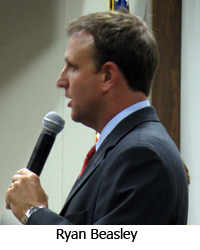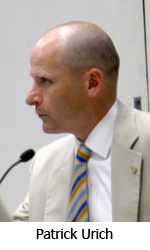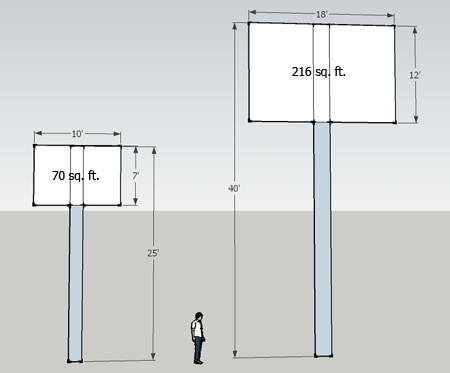In April, Peoria County applied for a $5 million grant through the Illinois Department of Commerce and Economic Opportunity (DCEO). A copy of the grant application was acquired from the County:
![]() DCEO Grant Survey – Peoria Riverfront Museum
DCEO Grant Survey – Peoria Riverfront Museum
The County listed itself as the “grantee” on page 2, and 203 SW Water St. (which is the City-owned Sears block) as the “project location” on page 4. Then, in answer to question 2d — “If the property is being improved, is the property owned by the grantee?” — the County checked the “Yes” box.
Question 10c asked, “If grant funds are to be utilized to make capital improvements to real property (structures/land) that your organization does not own [emphasis in original], provide a copy of the lease or other agreement (i.e., easements, rights-of-way. etc.) between your organization and the property owner that will allow your organization to continue to use the improved premises for an appropriate length of time, consistent with applicable state law and rules.” The County’s answer: “N/A.”
Question 10d asked, “Does your organization have an executed contract for the purchase/acquisition of the land/building in question?” The County’s answer: “N/A.”
Question 10g asked, “Provide the name, address, phone number and email address (if applicable) of the entity from which the land/building(s) is/are being purchased.” The County’s answer: “N/A.”
As you can see, the County consistently represented itself to the State as the owner of the land. When asked why, Peoria County Administrator Patrick Urich said:
By April when the grant survey was submitted, we had already negotiated the title transfer issue with the City of Peoria. As I said before, the redevelopment agreement has included language regarding title transfer since at least February, and by April, this issue had been to the County’s understanding, resolved. There were several other issues (paying permit fees, the commercial space approvals, the assurance that the funds would be there to build the museum, and what happens to the property if PRM no longer operates the museum) but the negotiating teams had moved on from the title issue.
That still doesn’t explain why this information wasn’t included on the grant application. The proper way to complete the application would have been to answer “No” to question 2d, and explain these negotiations in question 10d, at minimum. The questions couldn’t be any more specific; they clearly expect even anticipated ownership to be disclosed. The County misrepresented its ownership status no matter how one looks at it. No response was received from Urich to follow-up questions on this issue.
Other Questions
Urich’s answer raises another question: is it true that the title transfer issue with the City of Peoria had been resolved by April of this year? That was surprising, considering it has appeared as such a contentious issue here in August. I asked City attorney Randy Ray for some clarification. He replied:
There is no contract in place that requires the City to convey title to the Museum Site to the County.
It is true that there were negotiations, and draft agreements which contemplated such a conveyance. That was a major topic of a series of meetings with 3 or fewer council people that took place the first week of March, 2010. Obviously, those meetings did not convey the property, nor did anything else the City has done up to this point. If Council does not approve a Redevelopment Agreement, no conveyance will occur.
Ray acknowledges that negotiations did in fact take place, and we know from Urich’s statement that the County believed the issue of land conveyance was “resolved.” These negotiations were not just with City staff, mind you. There were “a series of meetings with 3 or fewer council people” at a time. Unfortunately, we’ll never know the real story because the City took great pains to completely skirt the Open Meetings Act (OMA).
The funny thing is that negotiation of the sale or lease of property can take place in closed session according to OMA, so why not just discuss it in executive session instead of these little meetings? Did they not want the negotiations on the record? (Minutes are taken during executive sessions.) Were they not giving the same information to each of the council members? Somewhere there seems to be a breakdown in communication because the City now appears reluctant to convey the land, but the County thought the issue was “resolved” way back in April.
Of course, there’s no legitimate reason not to conduct these negotiations in public, in open session. The reason property transactions are allowed to be conducted in secret is to protect taxpayers from market reaction. In this case, since the land is owned by one government body and being conveyed to another government body, there are no market forces and those concerns are moot.
During the 2005 mayoral campaign, then-candidate Ardis promised, “My leadership, a new generation of leadership, will be open, not closed; inclusive, not reserved for the select few; and bottom-up, not top-down.” Yet from the hotel deal to the museum, right up to the recent secret meeting with Ransburg — against whom Ardis ran in 2005 and, ironically, whom Ardis criticized for doing the public’s business in secret — he has not shown us this so-called “new generation of leadership.”

 Dave Ransburg and Ryan Beasley (the chair and vice chair of the Peoria Riverfront Museum, respectively) gave presentations on behalf of the Peoria Riverfront Museum. Ransburg stated that this will be the “greatest building built in Peoria since the Civic Center.” He also gave a brief history of how we got to this point, stressing that thousands of hours and millions of dollars have already been spent on this project.
Dave Ransburg and Ryan Beasley (the chair and vice chair of the Peoria Riverfront Museum, respectively) gave presentations on behalf of the Peoria Riverfront Museum. Ransburg stated that this will be the “greatest building built in Peoria since the Civic Center.” He also gave a brief history of how we got to this point, stressing that thousands of hours and millions of dollars have already been spent on this project. There was another speaker (didn’t catch his name, sorry) who provided an overview of the building and grounds. There will be three “free-standing” signs (they looked like monument signs in the illustration) that would be lighted. Also, on the large blank walls of the museum, there will be humongous banners that can be used for decoration and/or to advertise the movie(s) playing at the “giant screen” theater. The only entrances are the main entrance off of Washington street and the elevator entrance from the parking garage. Thus, most of the area around the museum will be dead space (i.e., there will be no meaningful pedestrian activity outside).
There was another speaker (didn’t catch his name, sorry) who provided an overview of the building and grounds. There will be three “free-standing” signs (they looked like monument signs in the illustration) that would be lighted. Also, on the large blank walls of the museum, there will be humongous banners that can be used for decoration and/or to advertise the movie(s) playing at the “giant screen” theater. The only entrances are the main entrance off of Washington street and the elevator entrance from the parking garage. Thus, most of the area around the museum will be dead space (i.e., there will be no meaningful pedestrian activity outside).